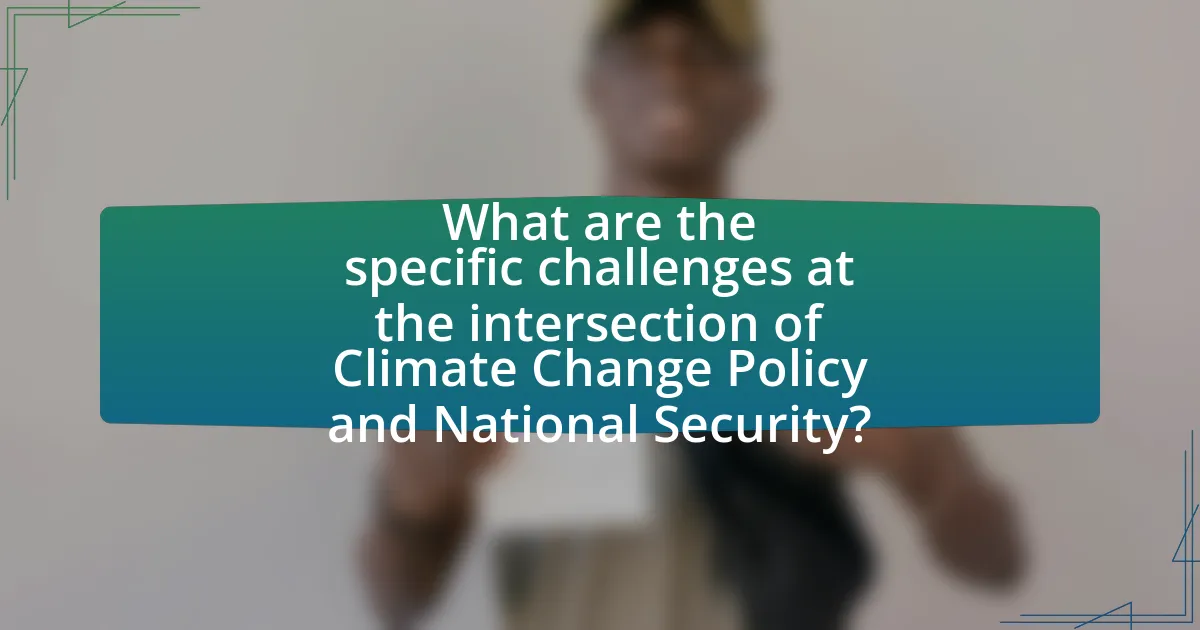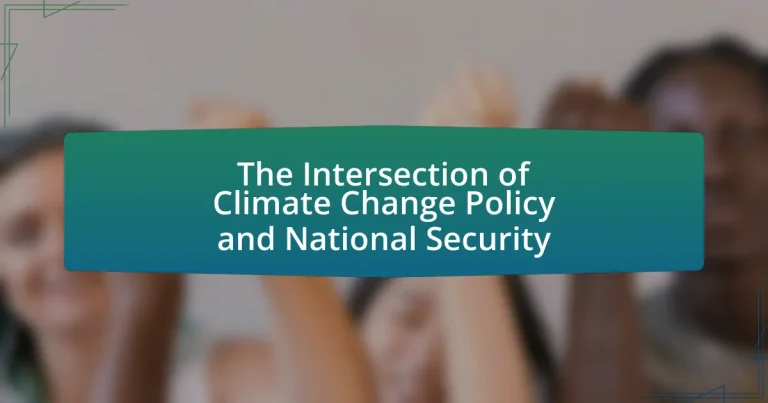The article examines the critical intersection of climate change policy and national security, highlighting how climate change acts as a “threat multiplier” that exacerbates resource scarcity, increases migration, and heightens the potential for conflict. It discusses the impact of climate change on national security strategies, emphasizing the need for risk assessment, resource management, and international cooperation. Key components include the influence of climate policies on military readiness and operations, the implications of climate-induced migration, and the economic costs associated with climate-related disasters. The article also outlines best practices for integrating climate considerations into national security frameworks and the importance of public awareness and collaboration among nations to effectively address these challenges.

What is the Intersection of Climate Change Policy and National Security?
The intersection of climate change policy and national security lies in the recognition that climate change poses significant risks to global stability and security. Climate change can exacerbate resource scarcity, lead to increased migration, and heighten the potential for conflict over dwindling resources, as evidenced by the U.S. Department of Defense’s 2014 Climate Change Adaptation Roadmap, which identifies climate change as a “threat multiplier.” This report highlights how extreme weather events and changing climate patterns can destabilize regions, particularly in vulnerable areas, thereby impacting national security interests.
How do climate change policies impact national security strategies?
Climate change policies significantly impact national security strategies by necessitating a reevaluation of threats and resource allocation. As climate change leads to increased natural disasters, resource scarcity, and population displacement, national security frameworks must adapt to address these emerging risks. For instance, the U.S. Department of Defense recognizes climate change as a “threat multiplier,” which exacerbates existing vulnerabilities and can lead to instability in regions critical to national interests. This acknowledgment has prompted the integration of climate resilience into military planning and operations, as seen in the 2019 National Defense Authorization Act, which emphasizes the need for climate adaptation strategies.
What are the key components of climate change policies affecting national security?
Key components of climate change policies affecting national security include risk assessment, resource management, and international cooperation. Risk assessment involves identifying vulnerabilities related to climate impacts, such as extreme weather events and rising sea levels, which can destabilize regions and threaten national interests. Resource management focuses on ensuring the availability and security of essential resources like water and food, which can be compromised by climate change, leading to conflicts. International cooperation is crucial for addressing transboundary climate issues, as climate change does not respect national borders; agreements like the Paris Agreement exemplify collaborative efforts to mitigate climate risks. These components are essential for developing comprehensive strategies that safeguard national security in the face of climate change challenges.
How do these policies influence military readiness and operations?
Climate change policies significantly influence military readiness and operations by necessitating adaptations in training, resource allocation, and strategic planning. For instance, the U.S. Department of Defense has recognized climate change as a “threat multiplier,” which impacts operational environments and increases the frequency of humanitarian missions due to natural disasters. This recognition leads to the integration of climate considerations into military exercises and infrastructure planning, ensuring that forces are prepared for diverse scenarios. Additionally, investments in renewable energy sources and sustainable practices enhance operational efficiency and reduce logistical vulnerabilities, thereby improving overall readiness.
Why is it important to consider national security in climate change discussions?
Considering national security in climate change discussions is crucial because climate change poses significant risks to national stability and safety. The impacts of climate change, such as extreme weather events, resource scarcity, and forced migration, can exacerbate existing geopolitical tensions and lead to conflicts. For instance, the U.S. Department of Defense has identified climate change as a “threat multiplier,” indicating that it can intensify issues like food and water shortages, which may destabilize regions and challenge national security. Additionally, the National Intelligence Council’s Global Trends report highlights that climate change will likely increase the frequency of humanitarian crises, requiring military and diplomatic responses. Thus, integrating national security considerations into climate change policy is essential for proactive risk management and safeguarding national interests.
What are the potential risks of ignoring national security in climate change policy?
Ignoring national security in climate change policy poses significant risks, including increased vulnerability to climate-related threats, geopolitical instability, and resource conflicts. For instance, as climate change exacerbates natural disasters, nations may face heightened internal strife and external pressures, leading to potential conflicts over dwindling resources such as water and arable land. The U.S. Department of Defense has identified climate change as a “threat multiplier,” indicating that it can intensify existing security challenges. Furthermore, failure to integrate national security considerations into climate policy may result in inadequate preparedness for climate-induced migration, which can destabilize regions and create humanitarian crises.
How can climate change exacerbate existing security threats?
Climate change can exacerbate existing security threats by intensifying resource scarcity, leading to increased competition and conflict over essential resources such as water and arable land. For instance, the United Nations has reported that climate change is expected to displace millions of people due to rising sea levels and extreme weather events, which can destabilize regions and create conditions for conflict. Additionally, the National Intelligence Council’s Global Trends report highlights that climate-related disasters can weaken governments and increase the likelihood of civil unrest, further compounding security challenges.
What role do international relations play in this intersection?
International relations play a crucial role in the intersection of climate change policy and national security by facilitating cooperation among nations to address shared environmental challenges. For instance, international agreements like the Paris Agreement exemplify how countries collaborate to set emission reduction targets, thereby linking climate action to global security interests. The U.S. Department of Defense recognizes climate change as a “threat multiplier,” indicating that international relations are essential for managing the security risks posed by climate impacts, such as resource scarcity and forced migration. This interconnectedness underscores the necessity for diplomatic efforts to create frameworks that integrate climate resilience into national security strategies.
How do global climate agreements affect national security priorities?
Global climate agreements significantly influence national security priorities by necessitating a shift in resource allocation and strategic planning to address climate-related risks. These agreements, such as the Paris Agreement, compel nations to reduce greenhouse gas emissions, which can lead to increased focus on energy security, disaster preparedness, and the management of climate-induced migration. For instance, the U.S. Department of Defense has recognized climate change as a “threat multiplier,” indicating that it exacerbates existing vulnerabilities and can destabilize regions, thereby impacting national security. Furthermore, studies show that countries that actively engage in climate agreements tend to prioritize resilience-building measures, which can enhance their overall security posture against both environmental and geopolitical threats.
What are the implications of climate-induced migration on national security?
Climate-induced migration poses significant implications for national security by increasing the risk of conflict, straining resources, and challenging governance structures. As populations displaced by climate change seek refuge, competition for limited resources such as water and arable land can escalate tensions between communities and nations. For instance, the United Nations High Commissioner for Refugees reported that by 2050, climate change could displace over 200 million people, potentially leading to instability in regions already facing socio-political challenges. Furthermore, governments may struggle to manage the influx of migrants, which can overwhelm infrastructure and public services, thereby undermining state authority and security. This dynamic has been observed in areas like the Sahel region, where climate-related migration has contributed to rising violence and insurgency.

What are the specific challenges at the intersection of Climate Change Policy and National Security?
The specific challenges at the intersection of Climate Change Policy and National Security include resource scarcity, increased migration, and heightened geopolitical tensions. Resource scarcity arises as climate change impacts water and food supplies, leading to competition among nations. For instance, the 2011 Arab Spring was partly fueled by severe droughts in Syria, which exacerbated social unrest and conflict. Increased migration occurs as populations flee climate-affected areas, creating potential security risks in host countries. The United Nations estimates that by 2050, climate change could displace over 200 million people. Heightened geopolitical tensions can result from nations competing for dwindling resources, as seen in the Arctic region, where melting ice opens new shipping routes and access to untapped resources, prompting territorial disputes. These challenges necessitate integrated approaches in policy-making to address both climate and security concerns effectively.
How do resource scarcity and climate change relate to national security?
Resource scarcity and climate change significantly impact national security by exacerbating tensions over limited resources, leading to conflict and instability. As climate change alters weather patterns and reduces the availability of essential resources like water and arable land, nations may face increased competition for these resources. For example, the 2011 Syrian civil war has been partially attributed to prolonged droughts that displaced rural populations, highlighting how resource scarcity can trigger social unrest and conflict. Additionally, the U.S. Department of Defense recognizes climate change as a “threat multiplier,” indicating that it can intensify existing vulnerabilities and challenges to national security.
What resources are most affected by climate change?
Water resources are most affected by climate change. Climate change leads to altered precipitation patterns, resulting in both droughts and floods, which significantly impact freshwater availability. According to the Intergovernmental Panel on Climate Change (IPCC), by 2050, up to 1.8 billion people could be living in areas with absolute water scarcity due to climate-related changes. Additionally, agricultural resources are also severely impacted, as changing climate conditions affect crop yields and food security. The Food and Agriculture Organization (FAO) reports that climate change could reduce global crop yields by up to 30% by 2050, exacerbating food insecurity.
How does competition for these resources lead to conflict?
Competition for resources such as water, arable land, and energy can lead to conflict as nations and communities vie for limited supplies. This competition intensifies due to climate change, which exacerbates resource scarcity by altering weather patterns and reducing agricultural yields. For instance, the 2011 Syrian civil war has been partially attributed to prolonged droughts that diminished water availability and agricultural productivity, leading to social unrest and conflict. Additionally, the Arctic region’s melting ice caps are opening new shipping routes and access to untapped oil and gas reserves, heightening tensions among countries like Russia, Canada, and the United States. These examples illustrate how resource competition, driven by climate change, can escalate into violent conflict.
What are the economic implications of climate change on national security?
Climate change has significant economic implications for national security, primarily through its impact on resource scarcity, infrastructure vulnerability, and increased migration. As climate change leads to extreme weather events and rising sea levels, it disrupts agricultural production, causing food shortages and price volatility. For instance, the U.S. Department of Defense has identified climate change as a “threat multiplier,” exacerbating existing vulnerabilities and increasing the likelihood of conflict over dwindling resources. Additionally, damaged infrastructure from climate-related disasters can strain national budgets, diverting funds from defense and security initiatives. The World Bank estimates that climate change could push over 140 million people into poverty by 2050, leading to mass migration and potential geopolitical instability. These factors collectively threaten national security by creating conditions ripe for conflict and instability.
How does climate change impact national economies and security funding?
Climate change significantly impacts national economies and security funding by increasing the frequency and severity of natural disasters, which leads to substantial economic losses and necessitates higher spending on disaster response and recovery. For instance, the National Oceanic and Atmospheric Administration reported that in 2020, the United States experienced 22 separate billion-dollar weather and climate disasters, costing the economy over $95 billion. This financial strain diverts resources from other critical areas, including national security, as governments must allocate more funds to address climate-related emergencies. Additionally, climate change exacerbates resource scarcity, leading to geopolitical tensions and conflicts, which further compels nations to increase their security budgets to address potential threats. The World Bank estimates that climate change could push over 130 million people into extreme poverty by 2030, creating instability that requires enhanced security measures.
What are the costs associated with climate-related disasters on national security?
Climate-related disasters impose significant costs on national security, primarily through increased military expenditures, humanitarian assistance, and infrastructure damage. For instance, the U.S. Department of Defense has reported that climate change exacerbates the frequency and intensity of natural disasters, leading to an estimated annual cost of $1.4 billion for disaster response and recovery efforts. Additionally, the National Oceanic and Atmospheric Administration (NOAA) indicated that the U.S. faced over $1 trillion in damages from climate-related events between 1980 and 2020, which directly impacts national security by straining resources and diverting attention from military readiness. These financial burdens highlight the critical intersection of climate change and national security, necessitating strategic policy responses to mitigate risks.
How can nations prepare for climate-related security threats?
Nations can prepare for climate-related security threats by implementing comprehensive risk assessments and developing adaptive strategies. These strategies should include enhancing infrastructure resilience, investing in renewable energy, and fostering international cooperation to address transboundary impacts. For instance, the U.S. Department of Defense has recognized climate change as a national security threat, leading to initiatives that integrate climate considerations into military planning and operations. Additionally, the Intergovernmental Panel on Climate Change (IPCC) reports highlight the need for proactive measures to mitigate risks associated with extreme weather events, food security, and resource scarcity, which can exacerbate conflicts. By prioritizing these actions, nations can effectively reduce vulnerabilities and enhance their security posture against climate-related threats.
What strategies can be implemented to mitigate these threats?
To mitigate threats at the intersection of climate change policy and national security, governments can implement strategies such as enhancing international cooperation, investing in renewable energy, and developing adaptive infrastructure. International cooperation can be strengthened through treaties and agreements that promote shared goals in climate resilience, as seen in the Paris Agreement, which aims to limit global warming and enhance adaptive capacities. Investing in renewable energy reduces dependence on fossil fuels, thereby decreasing vulnerability to energy supply disruptions and geopolitical tensions. Additionally, developing adaptive infrastructure, such as flood defenses and resilient urban planning, can protect communities from climate-related disasters, which are projected to increase due to climate change. These strategies collectively address the multifaceted risks posed by climate change to national security.
How can collaboration between nations enhance security in the face of climate change?
Collaboration between nations can enhance security in the face of climate change by fostering shared resources, knowledge, and strategies to mitigate risks. Joint efforts, such as international agreements like the Paris Agreement, enable countries to collectively reduce greenhouse gas emissions, which is crucial for limiting global temperature rise and its associated security threats, such as resource scarcity and forced migration. For instance, the United Nations Framework Convention on Climate Change (UNFCCC) facilitates cooperation among nations, allowing them to share best practices and technologies for climate adaptation and resilience. This collaborative approach not only strengthens national security by addressing the root causes of climate-related conflicts but also promotes stability through economic partnerships and humanitarian assistance in vulnerable regions.

What are the best practices for integrating Climate Change Policy into National Security frameworks?
The best practices for integrating Climate Change Policy into National Security frameworks include establishing a clear policy alignment, enhancing interagency collaboration, and incorporating climate risk assessments into national security strategies. Clear policy alignment ensures that climate change considerations are embedded in national security objectives, as evidenced by the U.S. Department of Defense’s Climate Adaptation Plan, which integrates climate risks into military planning. Enhancing interagency collaboration fosters a unified approach, exemplified by the U.S. National Security Council’s efforts to coordinate climate initiatives across various government sectors. Incorporating climate risk assessments into national security strategies allows for informed decision-making, supported by studies indicating that climate change can exacerbate security threats, such as resource scarcity and forced migration.
How can policymakers effectively align climate and security agendas?
Policymakers can effectively align climate and security agendas by integrating climate risk assessments into national security strategies. This approach ensures that potential climate-related threats, such as resource scarcity and displacement, are recognized as security issues. For instance, the U.S. Department of Defense has identified climate change as a “threat multiplier,” which underscores the need for military and security planning to incorporate climate impacts. By fostering collaboration between environmental and defense agencies, policymakers can create comprehensive strategies that address both climate resilience and national security, ultimately leading to more sustainable and secure societies.
What frameworks exist for integrating climate change into national security planning?
Several frameworks exist for integrating climate change into national security planning, including the National Security Strategy, the Department of Defense’s Climate Adaptation Plan, and the United Nations Framework Convention on Climate Change. The National Security Strategy outlines how climate change impacts national security by exacerbating resource scarcity and increasing the frequency of natural disasters. The Department of Defense’s Climate Adaptation Plan specifically addresses vulnerabilities in military installations and operations due to climate change, emphasizing the need for resilience and adaptation strategies. Additionally, the United Nations Framework Convention on Climate Change provides an international platform for countries to collaborate on climate-related security risks, promoting a comprehensive approach to integrating climate considerations into national security policies. These frameworks collectively highlight the recognition of climate change as a critical factor influencing global stability and security.
How can data and research inform policy decisions at this intersection?
Data and research can inform policy decisions at the intersection of climate change policy and national security by providing evidence-based insights that highlight the risks and opportunities associated with climate impacts on security. For instance, studies such as the “National Security and the Threat of Climate Change” report by the Center for a New American Security indicate that climate change exacerbates resource scarcity, leading to increased conflict and instability in vulnerable regions. This research enables policymakers to prioritize funding for climate resilience initiatives and develop strategies that mitigate security risks linked to climate-related events, such as natural disasters and forced migration. By integrating empirical data on climate trends and their socio-political implications, decision-makers can create more effective and proactive policies that address both environmental and security challenges.
What role does public awareness play in shaping policy at this intersection?
Public awareness significantly influences policy at the intersection of climate change and national security by driving public discourse and political action. When citizens are informed about the risks posed by climate change to national security, such as increased natural disasters and resource scarcity, they are more likely to advocate for policies that address these issues. For instance, a 2021 survey by the Pew Research Center found that 70% of Americans believe climate change is a major threat to the U.S., prompting policymakers to prioritize climate-related security measures. This awareness can lead to increased funding for climate resilience initiatives and the integration of climate considerations into national security strategies, as seen in the U.S. Department of Defense’s Climate Adaptation Plan, which acknowledges climate change as a critical factor in national security planning.
How can education and advocacy influence climate change and national security policies?
Education and advocacy can significantly influence climate change and national security policies by raising awareness and promoting informed decision-making among policymakers and the public. For instance, educational programs that highlight the links between climate change and national security risks, such as resource scarcity and migration, can lead to more comprehensive policy frameworks. Advocacy efforts, such as campaigns by organizations like the Center for Climate and Security, have successfully pushed for the integration of climate considerations into national security strategies, evidenced by the inclusion of climate change in the U.S. Department of Defense’s 2014 Climate Change Adaptation Roadmap. This demonstrates that informed advocacy can lead to actionable policies that address the multifaceted challenges posed by climate change to national security.
What are effective communication strategies for raising awareness on this issue?
Effective communication strategies for raising awareness on the intersection of climate change policy and national security include utilizing data-driven narratives, engaging stakeholders through collaborative platforms, and leveraging social media for broader outreach. Data-driven narratives, supported by statistics such as the National Security Strategy report highlighting climate change as a threat multiplier, can effectively convey urgency. Collaborative platforms, such as public forums and workshops, foster dialogue among policymakers, scientists, and the public, enhancing understanding and engagement. Social media campaigns can amplify messages, reaching diverse audiences quickly; for instance, the #ClimateSecurity hashtag has been used to mobilize discussions on this critical issue. These strategies collectively enhance awareness and drive action on the intersection of climate change and national security.
What practical steps can governments take to address this intersection?
Governments can implement integrated climate and security strategies to address the intersection of climate change policy and national security. This involves developing comprehensive assessments that identify climate-related risks to national security, such as resource scarcity and migration patterns. For instance, the U.S. Department of Defense has recognized climate change as a “threat multiplier,” prompting the integration of climate considerations into military planning and operations. Additionally, governments can enhance international cooperation on climate resilience, as evidenced by the Paris Agreement, which encourages nations to collaborate on reducing greenhouse gas emissions and adapting to climate impacts. By investing in renewable energy and sustainable infrastructure, governments can also reduce dependence on fossil fuels, thereby enhancing energy security and mitigating climate change effects.
What are the key recommendations for policymakers in this area?
Policymakers should prioritize integrating climate change considerations into national security strategies. This integration is essential because climate change poses significant risks to stability, resource availability, and geopolitical dynamics. For instance, the U.S. Department of Defense has identified climate change as a “threat multiplier,” exacerbating existing vulnerabilities in regions prone to conflict. Additionally, policymakers should enhance collaboration between environmental agencies and defense sectors to develop adaptive strategies that address both climate resilience and security needs. Investing in renewable energy and sustainable infrastructure can also mitigate risks associated with climate-induced resource scarcity, as evidenced by studies showing that renewable energy investments can lead to greater energy security and economic stability.
How can nations collaborate on joint initiatives to enhance security against climate threats?
Nations can collaborate on joint initiatives to enhance security against climate threats by establishing international agreements that focus on shared goals, resource allocation, and technology transfer. For instance, the Paris Agreement exemplifies how countries can commit to reducing greenhouse gas emissions collectively, thereby addressing climate change impacts that threaten national security. Additionally, nations can engage in joint research and development projects to innovate adaptive technologies, as seen in initiatives like the Global Climate Change Alliance, which fosters cooperation between developed and developing countries to build resilience against climate-related risks. These collaborative efforts are crucial, as climate change is projected to exacerbate resource scarcity and increase the frequency of extreme weather events, which can destabilize regions and lead to conflict.




